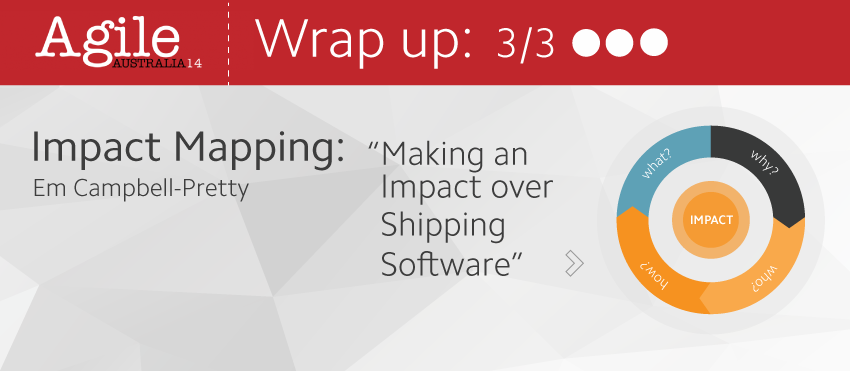In this final instalment on Agile Australia 2014, I’d like to briefly introduce you to “Impact Mapping” – a great new tool I learned from Em Campbell-Pretty. I’ll start with a high-level understanding of this tool then give you some resources to find out more. (If you missed my previous instalments you can check them out here: You are your process – Jim Benson and Trust – Glyn Thomas and Tim Hogan).
It’s a strategic planning tool that helps companies, teams or projects focus on building the right thing as opposed to building the thing right.
In her Agile Australia 2014 talk, Em gave us a real life example of how she used Impact Mapping to transform an originally ambiguous initiative into a clear understanding of the project requirements and impacts.
Impact Mapping focuses on answering four key questions:
Asking why, who, how and what initially seems a fairly simple approach. But, far too often, IT projects skip ahead to what needs to be delivered (i.e. the scope), and don’t understand why the project is important in the first place.
Using this tool forces you to think more thoroughly about your project to deliver a far greater outcome. Here’s a step-by-step breakdown of how to use Impact Mapping for your next project:
- Start by focussing on why you want to do your project. What goal will it deliver if you’re successful?
- Ask who the project will impact. Consider internal and external people, product/software… basically any one who has a stake in the outcome. This ensures you cater for everyone equally and don’t become too focused on just delivering the software.
- Investigate how the project will impact these people. How will their behaviours change when the project is completed? How can they help or impede the project?
- Look into what these people may need. As mentioned, many projects jump straight to what needs to be done but Impact Mapping gets you to do this last. This is essentially a scope identification exercise, but linked to who will be impacted and how.
As implied above, all these questions are linked to each other to form a mind map. As an example, the below was taken from the Impact Mapping site (http://impactmapping.org) to plan out a social online game with a goal of reaching 1 million players.
Impact mapping is interactive
Impact Mapping is an interactive workshop that brings both technical and strategic business people together. This ensures those working on a project appropriately understand why they are doing so.
It also allows the two groups to flesh out the project together and minimise assumptions. To do it justice, the site suggests going through the Impact Mapping exercise in full will take 2 days. (In Em’s example, she split this into smaller workshops over multiple days to accommodate her strategic business people’s busy schedules.)
The intent is to complete all activities using visual aids (i.e. post-it notes, flip charts, whiteboards, etc.). The main aim is to have everyone working collaboratively together in the same room and going through all the questions to understand the project in full.
Impact mapping is a great way to kick off a project
After listening to and processing Em’s presentation, I think Impact Mapping would be a great exercise to complete at the start of a project. It can assist with the planning phase and get everything off to a great start. In an Agile environment, it would be a good replacement for the Problem Statement or Elevator Pitch.
This is just a brief overview of Impact Mapping designed to trigger your interest. If you want to know more, here are some useful resources:
- Slides from Em’s Agile Australia 2014 presentation: view slides
- Em’s blog – “How I fell in love with Impact Mapping”
- Official Impact Mapping website: http://impactmapping.org/index.php
- Finally, and probably most importantly, the book!: http://impactmapping.org/book.php
I do hope you’ve learned a few things while reading these blogs about Agile Australia 2014.
The presentations from Agile Australia are available here >> presentations

